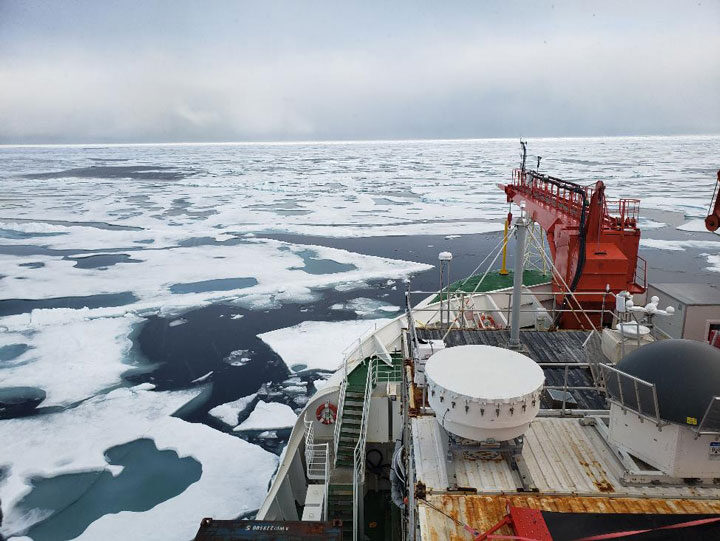Sea ice geophysicist Melinda Webster is blogging from the RV Polarstern, an icebreaker ship locked in Arctic sea ice for the MOSAiC expedition. Webster will use MOSAiC data as a blueprint to evaluate and extend the seasonal capability of data from NASA’s ICESat-2 satellite for sea ice research.
On August 17, the Polarstern reached the North Pole during its search for a new ice floe for the MOSAiC observatory, the research icebreaker Polarstern. We made surprisingly quick progress through the sea-ice pack owing to thin, warm ice conditions and a fragmented sea-ice cover. It took us less than seven days to cover 597 nautical miles (676 miles/1,087 kilometers) in a straight-line distance. The ice at the North Pole was level, seasonal ice extensively covered in dark melt ponds. I can only imagine how different it must have looked 30 years ago when thick, hummocky multiyear sea ice was more normal.

From the North Pole, we established a new ice camp at 87.717N, 104.313E on about 1.3-meter thick, first-year sea ice with numerous interconnected melt ponds. About half of the melt ponds were completely melted through to the ocean and the floe itself contained a network of old, melted cracks. These conditions required us to wear survival suits for much of our field work. After bouts of rain, snow, freezing, and melting, we were lucky enough to experience freeze-up, a time when the sea-ice cover begins to grow continuously from autumn to spring.
Two days ago, we completed our work at the snowy, frozen ice camp and began our journey to Bremerhaven, Germany. As we travel through the ice pack, we’re conducting “ice stations”–measurements collected at certain locations to capture the spatial variability in snow depth, melt pond depth, and sea ice thickness, which are important for understanding Arctic sea ice characteristics during the autumn transition. Yesterday, we observed snow cover that was about 8 centimeters deep, refrozen melt ponds, and “fields” of frost flowers on refrozen leads. Today, we’re traveling through wet first-year ice with open melt ponds covering about 25 percent of the area–a stark contrast from conditions yesterday due to a recent storm that passed through with above-freezing temperatures and rain.

As the Polarstern passes through changing ice conditions on our way southward, I can’t help but wonder what the sea-ice cover looked like 30 years ago and what it will look like 30 years from now.




How many more years to see the North Pole without an ice cap?